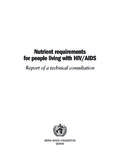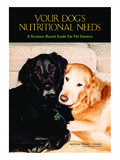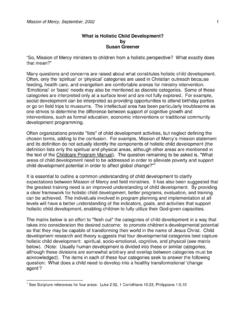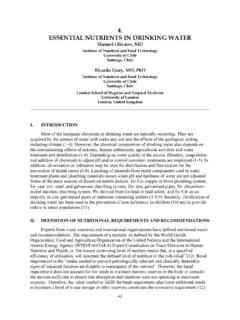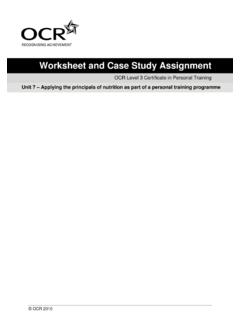Transcription of The Food Insecurity Experience Scale
1 1 The food Insecurity Experience Scale Frequently Asked Questions - FAQs WHAT does the food Insecurity Experience Scale measure? Q1 What is the Voices of the Hungry Project? .. 3 Q2 What does the food Insecurity Experience Scale (FIES) measure? .. 3 Q3 What does the FIES not measure? .. 4 Q4 does the FIES measure food Insecurity of children?..4 Q5 Is the FIES a food security indicator or a nutrition indicator? .. 5 Q6 Is the FIES a subjective measure? .. 6 WHY use the food Insecurity Experience Scale ? Q7 How does the FIES differ from other indicators of food Insecurity ? .. 7 Q8 What is the difference between the prevalence of food Insecurity , based on the FIES, and the Prevalence of Undernourishment (PoU) reported annually by FAO?
2 8 Q9 What are the potential uses of the FIES? .. 8 Q10 Is there a potential response bias due to respondent expectations of receiving assistance/benefits? .. 10 HOW is the FIES applied and analyzed? Q11 Is the FIES an individual or a household measure of food Insecurity ? .. 10 Q12 What is the reference period of the FIES? .. 11 Q13 Can the FIES items be applied and analyzed individually? .. 11 Q14 Is there a universal order in which the eight FIES questions fall along the Scale of severity? .. 11 Q15 What are the different classifications/levels of severity of food Insecurity and what do they mean?
3 12 Q16 How are the cut-points for classification of food Insecurity severity determined? .. 13 Q17 How does FAO present the global FIES results and what do they mean?..13 Q18 Are the questions and results of the FIES comparable across different cultures and countries? .. 14 2 Q19 In countries that already have their own national food security scales, is it possible that FAO s prevalence estimates for those countries may differ from figures published by national governments? .. 15 3 WHAT does the food Insecurity Experience Scale measure? Q1 What is the Voices of the Hungry Project?
4 A1 FAO launched the Voices of the Hungry (VOH) project in 2013 to provide up-to-date information about food Insecurity that is policy-relevant and actionable. The project developed a methodology to measure the severity of food Insecurity as experienced by individuals or households in a way that is comparable across countries1. Drawing on similar tools in the USA and Latin America, the project developed the food Insecurity Experience Scale (FIES) and innovative analytic methods aiming to provide a new global standard for measuring food Insecurity (access) that is valid, endorsed at the international level, and used for global and country monitoring.
5 Peer review of the methodology by a group of distinguished experts and National Statistics Offices in 2015 affirmed the scientific validity of the approach to produce national estimates of moderate and severe food Insecurity that are comparable across countries. For world-wide application of the FIES, VOH leverages on the Gallup World Poll (GWP), a branch of Gallup, Inc. that has conducted nationally representative surveys in more than 140 countries annually since 2005. Beginning in 2014, FAO contracted Gallup to collect data using the FIES in the World Poll questionnaire.
6 The data are used to derive estimates of the prevalence of food Insecurity at different levels of severity, gathered from a nationally representative sample of adults in all of the countries covered by the World Poll. (For more information on the GWP survey methodology access: ) An important goal of the VOH Project is to promote the adoption of the FIES methodology by national governmental institutions. The full potential of the FIES to generate statistics that can inform policy is realized when the tool is applied in larger national population surveys that enable more detailed analyses of the food Insecurity situation according to income, gender, age, race, ethnicity, migratory status, disability, geographic location, or other policy-relevant characteristics, as is already the case for a number of countries.
7 Q2 What does the food Insecurity Experience Scale (FIES) measure? A2 The FIES is a measure of access to food at the level of individuals or households. It measures severity of food Insecurity based on people s responses to questions about constraints on their ability to obtain adequate food . This approach to food security 1 4 measurement represents a significant change compared to traditional ways of assessing it indirectly through determinants such as food availability, or consequences such as poor quality diets, anthropometric failures, and other signs of malnutrition.
8 The FIES is derived from two widely-used Experience -based food security scales: the US Household food Security Survey Module and the Latin American and Caribbean food Security Scale (Spanish acronym ELCSA)2. It consists of a set of eight short yes/no questions asked directly to people, typically in face-to-face interviews, although they may be conducted by telephone as well. The questions focus on self-reported, food -related behaviors and experiences associated with increasing difficulties in accessing food due to resource constraints.
9 The FIES is based on a well-grounded construct of the Experience of food Insecurity composed of three domains: uncertainty/anxiety, changes in food quality, and changes in food quantity. These domains can be positioned on an underlying Scale of severity, as shown for example in Figure 1. The measure of food Insecurity associated with a respondent can be located on the Scale based on the number of positive responses to the questions (number of behaviors or experiences reported). Such measures are then used to classify respondents into categories of food Insecurity severity.
10 Mild food Insecurity Severe food Insecurity Uncertainty regarding ability to obtain food Compromising on food quality and variety Reducing food quantities, skipping meals Experiencing hunger Figure 1: food Insecurity severity along a continuous Scale Q3 What does the FIES not measure? A3 The FIES is not intended to quantify food consumption nor does it provide a quantitative assessment of dietary quality. It is not a measure of malnutrition and cannot be used to detect nutritional deficiencies or obesity. Consequently, it is not the appropriate tool for monitoring malnutrition or assessing nutrition-specific outcomes of food security programs and policies.











